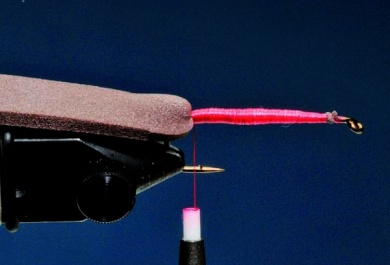The Fat Albert is an interesting variant of the Chernobyl Ant with a bigger and bulkier body. It hits the water clearly calling trout´s attention. With some variations, we have used it successfully to catch golden dorados and other smaller South American species, like pira pita and pacú. There are View more...The Fat Albert is an interesting variant of the Chernobyl Ant with a bigger and bulkier body. It hits the water clearly calling trout´s attention. With some variations, we have used it successfully to catch golden dorados and other smaller South American species, like pira pita and pacú. There are endless variants of this fly, some have fluorescent wool on the back to make it easy to spot and others have dubbing on the under body.The new barred silicon legs –like the ones on Centipedes- used for this Fat Albert, add some attractive to this effective fly, which works like a charm in fast waters, pockets and deep pools. In lakes, casting it close to the line where it gets deep it is very useful, especially on windy days when the moving waters make it a killer pattern. In spite of its big size, the strikes tend to be soft; I recommend you stay focused.
Move the mouse over the image to zoom in the fly.
Touch the image to zoom in the fly.

List of materials
Tying MaterialsHook: because it catches big fish, I use short streamer hooks instead of dry fly ones, the Daiichi 1720 is strong enough. The fly on the pictures is tied on a size 6 hook. If you are going to use shock leaders, use a straight hook. I have tied this fly in all sizes ranging from 4 to 12.Thread: 3/0 monocord, red. It should be resistant and wide enough not to cut the foam. Turn the bobbin to untangle the thread and to keep it flat like tape.Body: foam of about 2mm thick. Use a dark View more...Tying MaterialsHook: because it catches big fish, I use short streamer hooks instead of dry fly ones, the Daiichi 1720 is strong enough. The fly on the pictures is tied on a size 6 hook. If you are going to use shock leaders, use a straight hook. I have tied this fly in all sizes ranging from 4 to 12.Thread: 3/0 monocord, red. It should be resistant and wide enough not to cut the foam. Turn the bobbin to untangle the thread and to keep it flat like tape.Body: foam of about 2mm thick. Use a dark one and a clear one to make a difference in sections. This is optional, for single-color Fat Alberts are also killers, all-blacks are great.Legs: barred silicon like the ones on Centipedes, by Montana Flies.Wing: Antron or Gator Hair, white.
Steps
Step 1
We have two foam straps with a triangle cut in its tip, to make the tying easier. The brown foam is wider than the orange one. It is 1 ½ times the hook gap. But try several sizes until you get the desired effect.
Step 2
Tie the brown foam behind the hook eye. Tie towards the hook bend, on the upper section. The turns should be even and close by, so they cover the foam. It will compress and disappear below the thread. Tie the foam up to where the hook is bent, and tie 2mm more on the curve.
Step 3
Go back to where you started to tie the brown foam and tie the orange one in the same way. Make sure you cover the foam again so it is a neat underbody.
Step 4
Take the thread to the front, lower the orange foam and with 6 to 10 turns make the first segment. Lift the orange foam, take the thread to the front, lower the foam and make the second segment. And so on until you have all the sections, the last one under the thorax should be wider. The thread ends up close to the hook eye. The picture shows the foam from below too.
Step 5
Lower the foam and tie it where we tied the last section. Close to the eye and making 6 to 10 turns. Once the brown foam is tied, cross the thread through the back and tie the foam of the back as seen in the picture. The crossed thread is covered later on.
Step 6
Tie a strap of white antron or gator hair, partly towards the back and partly to the front. Then bend the front one to make the wing. Cut the wing where the body ends, tie an orange foam strap on top and tie a couple of barred rubbers at the sides with the correct inclination. Repeat this on the other side.
Step 7
Tie the front legs too. Make sure the ones from the back do not get in the way, use tape or copper wire to hold them aside.Lower the orange foam strap, tie it firmly and cut the short foam on the front and the long one on the back. Turn the fly upside down and cement the thread that was left exposed to finish our Fat Albert. Cianoacrylate is very good for this but it gets whitish on humid days, worsening the fly. I recommend 5 minute epoxy and a thin brush, cleaned with acetone or thinner. View more...Tie the front legs too. Make sure the ones from the back do not get in the way, use tape or copper wire to hold them aside.Lower the orange foam strap, tie it firmly and cut the short foam on the front and the long one on the back. Turn the fly upside down and cement the thread that was left exposed to finish our Fat Albert. Cianoacrylate is very good for this but it gets whitish on humid days, worsening the fly. I recommend 5 minute epoxy and a thin brush, cleaned with acetone or thinner.








